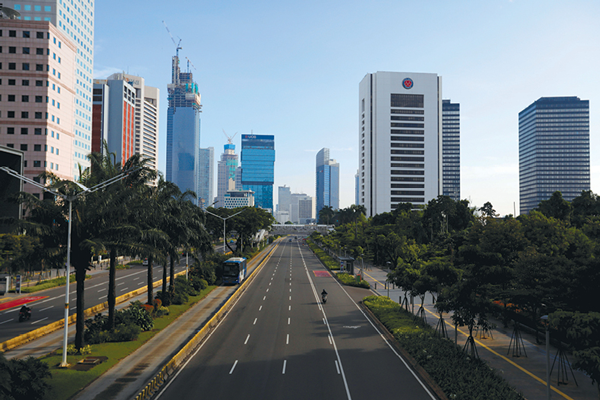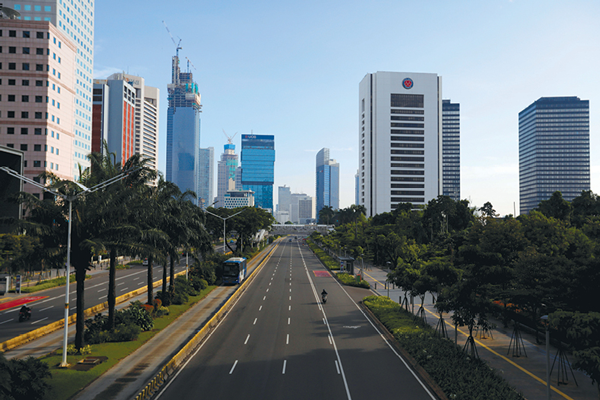
Indonesia’s President Joko Widodo has prioritised infrastructure as one of his key development goals, but given the severity of which COVID-19 has hit Indonesia, this focus has been put on the back burner somewhat. While developments may have slowed, lawyers are conscious these projects are a long-term commitment, and sooner rather than later, the industry will bounce back.
The scale of Jokowi’s infrastructure development plans is ambitious. Defrizal Djamaris, managing partner of Kudri & Djamaris, says that data obtained from Komite Percepatan Penyediaan Infrastruktur Prioritas (Committee for Acceleration Provision of Priority Infrastructure) reveals that Indonesia’s government has 245 national strategic projects grouped into 15 categories.
“The 15 sector projects include education infrastructure, road, train, seaport, airport, economic zone, housing, boarder water resources, irrigation, technology, smelters, energy marine and agriculture, sea wall program, sector electrical, and aircraft industry growth,” he outlines. But while the scale of these projects is far-reaching, they do face several significant challenges Djamaris says. Chief among these are “land acquisition, financing, poor preparation on infrastructure projects, and the outbreak of COVID-19.”
While most challenges are consistent with earlier concerns expressed by lawyers, it is undeniable that the outbreak of COVID-19 has had a significant impact on Indonesia’s ability to currently carry out such projects.
“Numerous infrastructure projects most likely will be suspended,” says Djamaris. Among these are “the development of the Kuningan East Ring Road in West Java, the Jragung Dam in Central Java, the Way Sekampung Dam in Lampung, the Temef Dam in East Nusa Tenggara, the construction of the Brebes Ring Road in Central Java, the irrigation network in Baro Raya in Pidie, Aceh, revamping the waterfront area in Pariaman, West Sumatra, and building the Sp Tohpati - Tjokroaminoto bridge in Denpasar, Bali” he says, following the government’s decision to reallocate a large part of its budget funds to the COVID-19 pandemic relief efforts.
LAND COMPLICATIONS
When infrastructure projects are fully in progress, lawyers play a critical role in the development process Ivan Baely, managing partner at IABF, says. Primarily, lawyers working on infrastructure development projects are representing and assisting clients engaged in tenders held by the government. Lawyers are the ones who ensure that clients can participate in such tenders following applicable laws and regulations says Baely.
“After this stage, we will assist our clients to review the Engineering Procurement and Construction (EPC) contracts, cooperation agreement, and other related agreements after the client has been appointed in the tender,” he says.
“In some cases, the process may include land acquisition with community-landowners and our role in these situations is either to assist clients in mediation with the landowners or to proceed with court proceedings if there is a dispute in the land acquisition process,” Baely adds.
But for lawyers who are guiding clients through the process, challenges remain.
“The biggest challenge that may occur during an infrastructure project is in the process of land acquisition,” Baely says, adding that there can be clashes with the landowner, in cases when the land is set to be used for infrastructure development.
“Based on our past experiences and what usually happens in practice is that this issue arises because of the landowner rejects the value of the compensation value or several parties claim to be the party entitled to receive compensation for such land acquisition,” he says.
To mitigate these complex issues, lawyers need to ensure they conduct due diligence around the legality of the land ownership “and to determine the appropriate compensation value to be given to the rightful landowner before the client conducts the land acquisition process,” says Baely.
While such issues are not unusual when it comes to infrastructure development projects, Baely is hopeful that in the future, such problems may be able to be mitigated against.
“Hopefully in the future the government can formulate a regulation to facilitate the process of land acquisition and the process of handling the dispute in court so that it doesn’t postpone and protract the infrastructure process,” he says, adding that these changes will make is easier to realise Jokowi’s infra-structure development ambitions “as soon as possible,” Baely adds.
Djamaris also agrees that land acquisitions have posed significant issues in government infrastructure projects. “The projects are often stalled due to people’s refusal to relinquish their land rights, disputes on land ownership, or where one group claims to be rightful owner certain land when settlement is achieved,” he adds.
And these aren’t just hypothetical issues. “The Kemayoran – Kampung Melayu toll road, Sunter-Rawa Buaya, Batu Ceper, Pasar Minggu-Casablanca and the construction of the PLTU Batang, Kulon Progo Airport are concrete examples of infrastructure development that has faced obstacles in land acquisition,” Djamaris says.
These challenges continue to persist despite the government being proactive in the past with land acquisition laws. “The government has issued laws and regulations to accelerate the land acquisition process — notably the 2012 Land Acquisition Law — this improved regulation leads to the pertinent question of how these regulations are being implemented,” Djamaris adds.
The enforcement of regulations is a reoccurring theme for lawyers in the market, as are gaps in tools or initiatives. This can also be seen in the Indonesian government’s recently launched One Map Policy Geoportal (KSP Geoportal). The tool, which is intended to be used for project planning aims to offer a more detailed view of land use, to minimise overlapping ownership claims.
But the Map Policy Geoportal still has weaknesses that need to be addressed to meet its design says Djamaris. “Though the government agencies have the authority to make their sectorial maps, no one standardised map existed, resulting in overlapping and conflicting claims to land,” he adds.
To mitigate and address these issues, ministries and government agencies should be required to synchronise thematic maps from different governmental agencies, he says. He cites the main obstacle developing this policy as “the reluctance of government agencies to collaborate, chiefly those that have the authority to issue permits.”
This will also likely require some-thing of a mindset shift. “The policy is also not a merely technical process, it is hugely political therefore it requires the involvement contestation among government agencies and between government and wider public participation or communities,” Djamaris notes.
But other issues remain prominent for lawyers tackling such projects. Among these are financing and poor preparation around infrastructure projects. These also require solutions for projects to run smoothly, they believe.
WEATHERING THE STORM
Given the challenges that remain, and will continue to persist post-COVID-19, the easing of bottlenecks in the form of future reforms will continue to be important, lawyers say. “Further reform from the government is required to help smooth the infrastructure projects,” Baely says, adding this should appear in the form of a new regulation.
Djamaris agrees that in the immediate future, action is needed to achieve all the priorities set out by Jokowi. He adds that this will also be important when it comes to staving off the greater impacts of COVID-19.
The government needs to “apply emergency regulation in regards to the outbreak of COVID-19 in Indonesia to sustain all sectors to be stable,” says Djamaris, adding that the government has “properly handled” the situation by enacting a number of regulations to combat the outbreak “without too much compromising the economy.”
The se namely include : “Government Regulation No. 1 of 2020 on State Financial Policies and Financial System Stability for Handling the COVID-19 Pandemic and/or in the Context of Facing Threats that Endanger the National Economy and/or Financial System Stability; Minister of Finance Regulation No. 23/PMK.03/2020 on Tax Incentives for Taxpayers affected by the Corona Virus Outbreak; Minister of Finance Regulation No. 28/PMK.03/2020 on Provision of Tax Facilities on Goods and Services Needed in the Context of Handling Pandemic COVID-19; Director-General of Taxes Decision No. Kep-156/PJ/2020 on Taxation Policy Regarding the Spreading of Corona Virus Outbreak 2019; and many other regulations related to the impact of the outbreak of COVID-19,” Djamaris adds.
But further reform of bureaucracy is needed. “One of the results of the complicated bureaucratic system in Indonesia is lack of intention from investors to conduct business and/or investment in Indonesia,” Djamaris says, adding that further reform will help to clarify access for investors to conduct business and/or investment in Indonesia.
But there is hope. In cases where such bottlenecks have been tackled, there have been results. “The government has realised that permit regulation in Indonesia is complicated and has taken action by establishing one gateway system for permit management for companies called OSS (Online Single Submission) system through OJK (Financial Services Authority of Indonesia),” Djamaris says, explaining this system is designed to simplify and clarify the mechanism through which companies obtain certain business permits in Indonesia. “[They have] succeeded in shortening a very complicated mechanism for companies to obtain permit in Indonesia,” he adds.
To contact the editorial team, please email ALBEditor@thomsonreuters.com.



